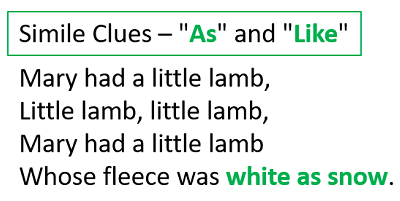 Literary Devices
Literary Devices
Literary Devices
Literary Devices

 Literary Devices
Literary Devices
Literary Devices
Literary Devices

Study the poem for one week.
Over the week:
Poets often use literary devices, defined as 'rules of thumb, convention, or structure that are employed in literature and storytelling.'
The nine literary devices we'll study include:
Similes are figures of speech comparing two things, generally using 'like' or 'as'.
Study the poem excerpt from 'Mary Had a Little Lamb' by Mother Goose and identify the simile.

Activity 1: Recite Poem Information
Recite the title of the poem and the name of the poet.
Activity 2: Study the Poem Picture
Study the poem picture and describe how it relates to the poem.

Activity 3: Recite the Poem
Practice reciting the poem aloud.
Activity 4: Identify 'Like' or 'As'
Read the similes aloud.
Identify the simile clues - 'as' and 'like.'
Activity 5: Identify the Rhyme Scheme
Review the poem excerpt. Does it follow a traditional (ABAB), couplet (AABB), enclosed (ABBA), or triplet (AAABBB) rhyming scheme?
Activity 6: Identify Alliteration
Activity 7: Identify Similes
Review the poem excerpt and identify the similes.
Name the pairs of elements that the similes compare.
Review the full version of the poem. Can you find an additional simile?
Activity 8: Complete Book Activities
